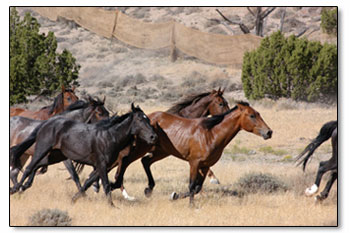|
|
A case for harvesting horsesby Ari LeVaux The opening of the Valley Meat slaughterhouse, and the outcry it has provoked among some horse-lovers, highlights the complex relationship Americans have with horses. To many, horses are friends, up there with dogs and cats, and the thought of killing them is deeply disturbing. The problem is, Americans love horses so much that we have too many of them. The racehorse industry produces a regular supply of spent thoroughbreds and quarter horses. Farmers and ranchers have to dispose of old workhorses, as do big-city horse-drawn carriage operators. In the cold light of the bottom line, selling used-up horses rather than paying to keep them alive is a logical choice. Since Congress has stopped funding activities related to horse slaughter, in 2007, unwanted horses have been auctioned off to meat buyers and quietly shipped to Mexico and Canada for slaughter. Last year, nearly 200,000 were shipped across the border, in a journey that is often brutal. These retired workhorses, including their edible flesh, can contain vaccines, antibiotics, steroids, painkillers and other medicines unapproved for use in food animals. For this reason, the European Union, some member countries of which have a taste for horse flesh, is planning to be more selective about the horsemeat it allows in. There are similar stirrings in Japan and Russia, other big consumers of horsemeat, which could follow suit. Meanwhile, a burgeoning population of mustangs is roaming the arid open spaces of the West, often in dense-enough numbers to become an ecological nuisance. While often called “wild,” these free-roaming horses (and burros) are descended from animals brought over by Europeans. They are an introduced, invasive species, with few predators to worry about. “Horse populations left in the wild, unmanaged, would double in size every four years,” Paul McGuire, Public Affairs Specialist at the Oklahoma Field Office of the Bureau of Land Management, told me by phone. “The land cannot sustain that kind of growth in horse populations.” The BLM spends $75 million annually to manage the mustangs that live on federal land. This budget includes $43 million dedicated to “holding costs” for approximately 40,000 “excess horses” that have been removed from their range, and currently reside on five long-term facilities in Kansas and Oklahoma. The animals deemed most adoptable, meanwhile, are held in one of 54 facilities across the central and western United States. According to a report on the BLM website, these facilities are currently at capacity. Animals that aren’t adopted join the others in a long-term pasture. Perhaps these free-roaming horses are the ones that should be slaughtered. The animals are coming from clean, if not pristine, environments. Given the changing preferences among the world’s purchasers of U.S. horsemeat, the market prospects for clean meat from free-range horses are good. Why spend money maintaining something that you could make money by selling? As long as the American relationship with horses remains so conflicted, with a powerful horse-loving lobby holding the stronger hand, sensible horse management policy might not be in the cards. Until Congress decides otherwise, millions of taxpayer dollars will be spent each year to manage and protect an invasive species that also happens to be a great source of lean protein, has legitimate market value, and is delicious. I’ve tried it myself: stir-fried donkey in China, which was like a sweet cross between beef and pork, and canned horsemeat in Mongolia, which was better than Spam. Lynn Montgomery lives in Placitas, N.M., a rural community surrounded by open space that is home to several herds of wild horses. Many people in the community treat the horses like outdoor pets, even providing them food and water. It’s common in Placitas to have cars stopped in the middle of the road, folks just ogling a herd. “I love the horses,” Montgomery told me. “But I also love the kangaroo rats and all the plants and animals and birds that the horses impact. In the drought we’re in, the horses are just devastating. They make trails, which turn into arroyos, which funnel the rain and carve away the land. And when those rare but ferocious drought rains come, it’s a total mess.” The horses also destroy gardens, break fences, get into springs, and foul people’s drinking water, including Montgomery’s. “People’s right to look at horses shouldn’t trump my right to clean water,” he said. Sending wild horses, like those in Placitas, to slaughter seems like the best way to handle the exploding population of this beautiful, sensitive, noxious weed of an animal. Instead we’re ignoring this resource out of some vague principle. “When I was growing up in the 1940s the stores carried Hill’s Horsemeat,” Montgomery told me. “The label said, ‘For Pet Food Only,’ but it had a USDA stamp, so people took it home and ate it. My mom made a wonderful salad, like tuna fish salad with mayonnaise and onions, and we made sandwiches,” Montgomery said. If we began harvesting horses, perhaps prospective horse adopters would consider sheltering an old horse instead, a horse that’s already given its best years to some human cause. Arguably, those are the horses that most deserve pampering. And once those E.U. restrictions on horsemeat go into effect this summer, old horses with medical histories will probably be less wanted than ever. |
In this week's issue...
- September 11, 2025
- Back on top
After harrowing flying accident, local highliner steps back out with renewed mission
- September 11, 2025
- New order
Rule change for Land and Water Conservation Fund raises alarms
- September 4, 2025
- Armed with knowledge
Local community organizers work to ensure immigrant neighbors know their rights


